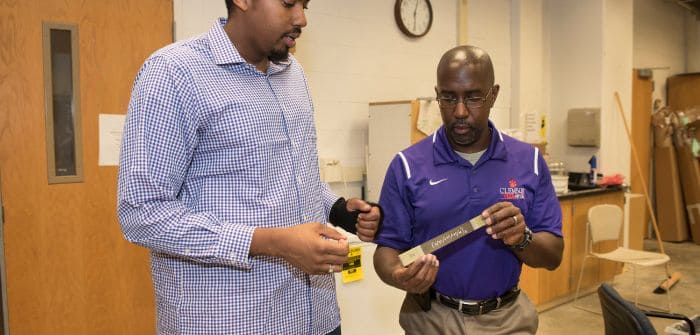New research being conducted at Clemson University and funded by the US Army Research Laboratory could see the creation of smart materials that sense damage, similar to how nerves tell the body it has been injured.
The idea is that magnetically sensitive material would be embedded within the smart material throughout the vehicle and act as a sensor to recognize when there is damage.
Just as pain is relayed to the brain, the damage report would go to a computer and help determine whether a vehicle should keep going or return to the depot.
Oliver Myers (above: right, with mechanical engineering master’s student Brandon Williams, left), an associate professor of mechanical engineering, explained, “In the field we need that self-diagnostic capability. Lt Cmdr Data in Star Trek always says, ‘I’m performing within specified parameters.’ We want to make sure our platforms are performing to those specified parameters at a minimum.”
The team has looked at sandwiching magnetostrictive material between multiple layers of composite materials, creating a laminate. The magnetostrictive material responds to a magnetic field or a change in stress, allowing it to act as the nerve that senses the damage. The types of damage it could detect includes impacts, cracking and unusual loading.
“Part of what makes the team’s approach unique is that the magnetostrictive material that senses the damage is embedded in the structure itself during the fabrication process, rather than attaching sensors after the structure is already built. Those external sensors often require additional equipment. The magnetostrictive material requires no power, is lightweight and operates in harsh environments,” Myers said.
One other central focus under investigation is how to create a robust sensing operation using the embedded magnetostrictive material. “Robust would mean it is observable, repeatable, measurable and sustainable. We want this to not only be a benchtop experiment, but we want to be able to put it on larger structures and larger systems so that once we go from the benchtop coupon level we go to a full-size system and have it function as an NDE, or nondestructive evaluation, structural health-monitoring platform,” Myers commented.
He estimates introduction to the market could be in 10 to 20 years.


